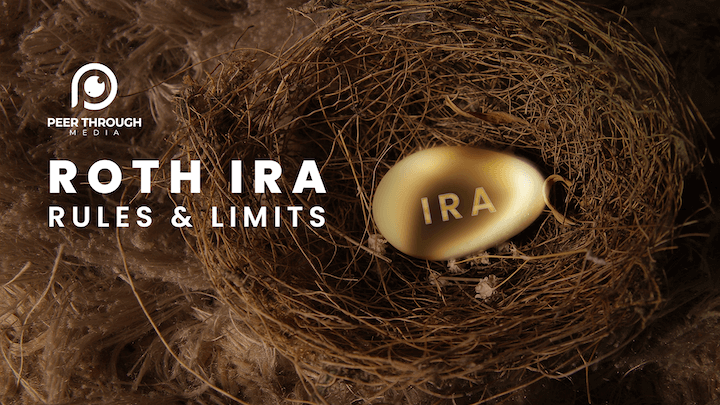Roth IRA: Rules & Limits
Roth IRA is a popular choice for most investors. And its popularity is only going up (especially among millennials).
In this article, we’re going to take a look at some of the rules and limits that you need to be mindful of while choosing the Roth IRA.
Note: This article is for entertainment purposes only. None of it should be considered tax, financial or legal advice. Always consult your accountant before making any major retirement decisions.

What is an IRA?
Individual Retirement Account (or IRA), as the name suggests is a retirement account. With this account, you can invest your money in multiple financial instruments like stocks and bonds, crypto IRAs, Gold & Silver IRA and more to get tax-deferred income. It is quite popular since there’s no cap or tax on your investment’s yield.
Further Reading: The Best Crypto IRAs
What is a Roth IRA?
Roth IRA is a type of IRA that gives you tax-free dividends on post-tax dollars.
What this means is that you pay taxes on the amount of money you’re investing upfront. But you won’t have to pay any taxes on the dividends you get.
Sounds great? It is! But there’s a catch: your annual income needs to be within certain limits.
What are the maximum income limits on Roth IRA accounts in 2022?
Your modified annual gross income (AGI) serves as the basis for the Roth IRA income restrictions. If your earnings are over the maximum amount, you’re going to be penalized should you decide to make any contributions.
In addition, if your income exceeds the minimum phase-out limit, your contribution limit will be reduced.
As of 2022, if you’re married and filing jointly, or if you’re a qualifying widower, the cap is $214,000. If you’re the head of the household, or are single, or are married and filing separately and living separately, the cap is $144,000. If you’re married and filing separately, but living together, the cap is $10,000.
What are the minimum income limits on Roth IRA accounts in 2022?
If you’re married and filing jointly, or a qualifying widower, the lowest limit is $204,000. Else if you’re the head of the household, or are single, or are married and filing separately and living separately, the lowest you’re allowed to go for is $129,000. If you’re married and filing separately, but living together, $0 is the lowest limit for you.
You can determine your decreased contribution amount using the IRS spreadsheet if your income is within the phase-out range. As long as you have earned at least an equivalent amount of taxable income, you will be allowed to contribute the maximum amount for that year if you fall below the phase-out threshold.
What would happen if you surpass the Roth IRA income limit?
For each year that excess Roth IRA contributions are held in an account, the IRS levies a 6 percent excise tax.
Let’s take an example wherein your income is above the cap but you still contribute $6,000 to a Roth IRA account. You might wind up owing about $360 a year (PLUS 6% of the $6,000 in interest income). As long as the extra money remains in your account, the tax would be due every year.
If you’ve given more than you should have, withdraw it (and your resulting earnings) before the deadline for filing your tax return for that year. Doing this would save you from the 6% tax that IRS would’ve levied otherwise.
Related Articles: iTrustCapital Review
What is the 5-year rule in Roth IRA?
Withdrawals from a Roth IRA must be regarded as “qualified distributions” in order to be exempt from taxes. You must meet the five-year rule and be at least 59 ½ years of age while requesting a payout in order for it to be qualified.
After making the initial Roth IRA contribution, you have to wait for five years to pass to comply with the five-year rule.
So if you’re 57 years of age when you start a Roth IRA and try to withdraw money when you turn 60, it won’t be tax-free since you haven’t met the five-year requirement. You’d have to hold off until you’re at least 62 years old.

Roth IRA vs. 401(k): What’s the difference?
Roth IRA is different from 401 (k) in a few ways.
Employees have access to 401(k) plans through their employers, whereas individuals open Roth IRAs with financial institutions on their own.
In 401(k)s, the investment and withdrawals are both taxed, unlike Roth IRAs. But then, 401(k)s do not have income restrictions. And you can contribute significantly more annually, with your employer probably matching some of it.
While Roth IRAs don’t demand distributions ever, 401(k)s normally start requiring them once you turn 72.
You can use a Roth IRA to save money for retirement and take advantage of tax-free growth. It’s especially helpful if you anticipate paying higher taxes in the future. But if your annual income is high already, it won’t be a wise choice.
Additionally, your 401(k) account may offer a larger return on investment if your employer matches your contributions to the plan.
Your annual income, employment situation, tax filing status, and anticipated future tax rates will all affect which option is best for you. Compare a Roth IRA with other choices like traditional IRAs and 401(k)s before making a decision.
Also, remember that you don’t have to put all eggs in one basket. It may be advantageous in some circumstances to divide your retirement money among other types of accounts.
With this article, we’ve discussed the rules and limits of the Roth IRA. Happy investing!









